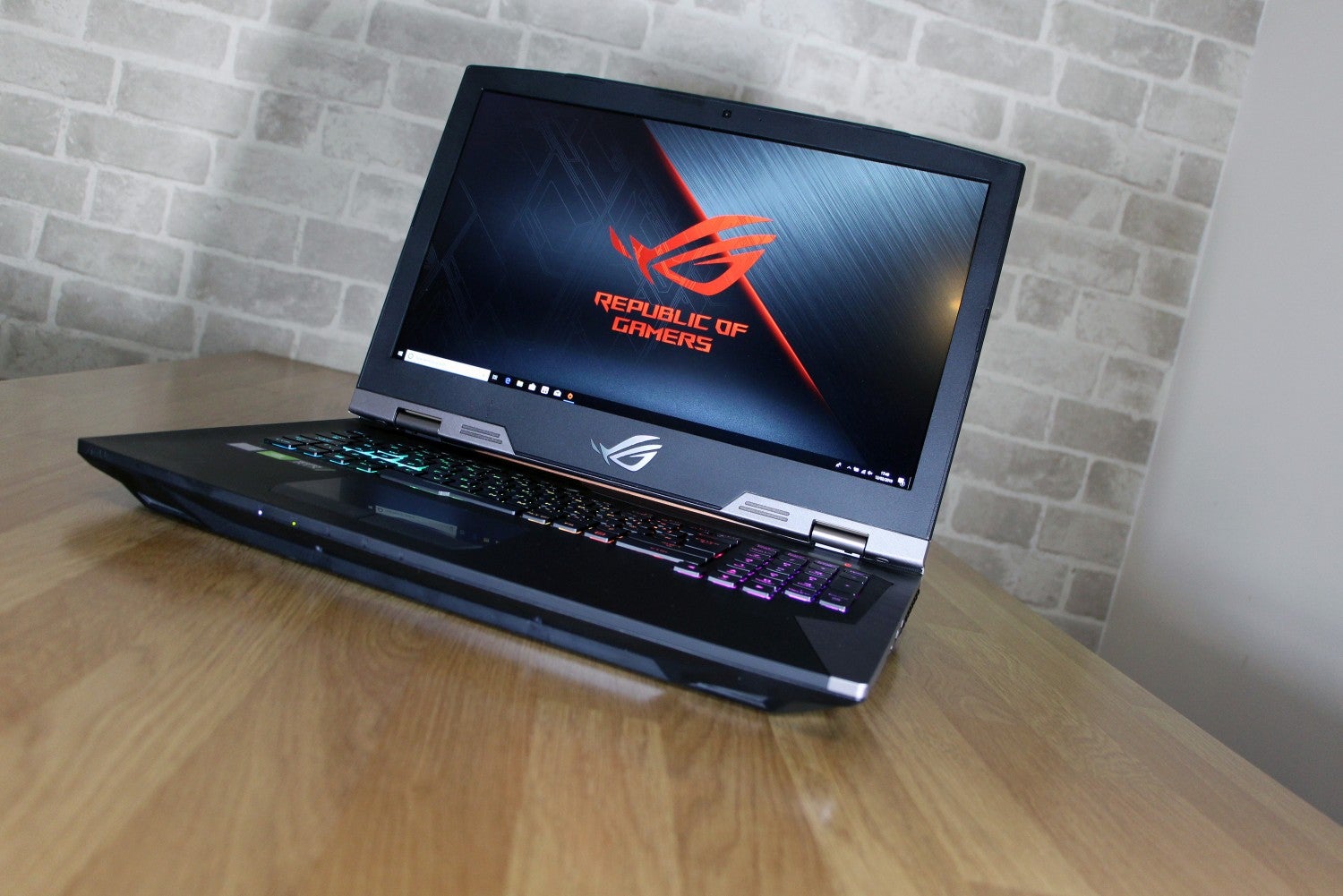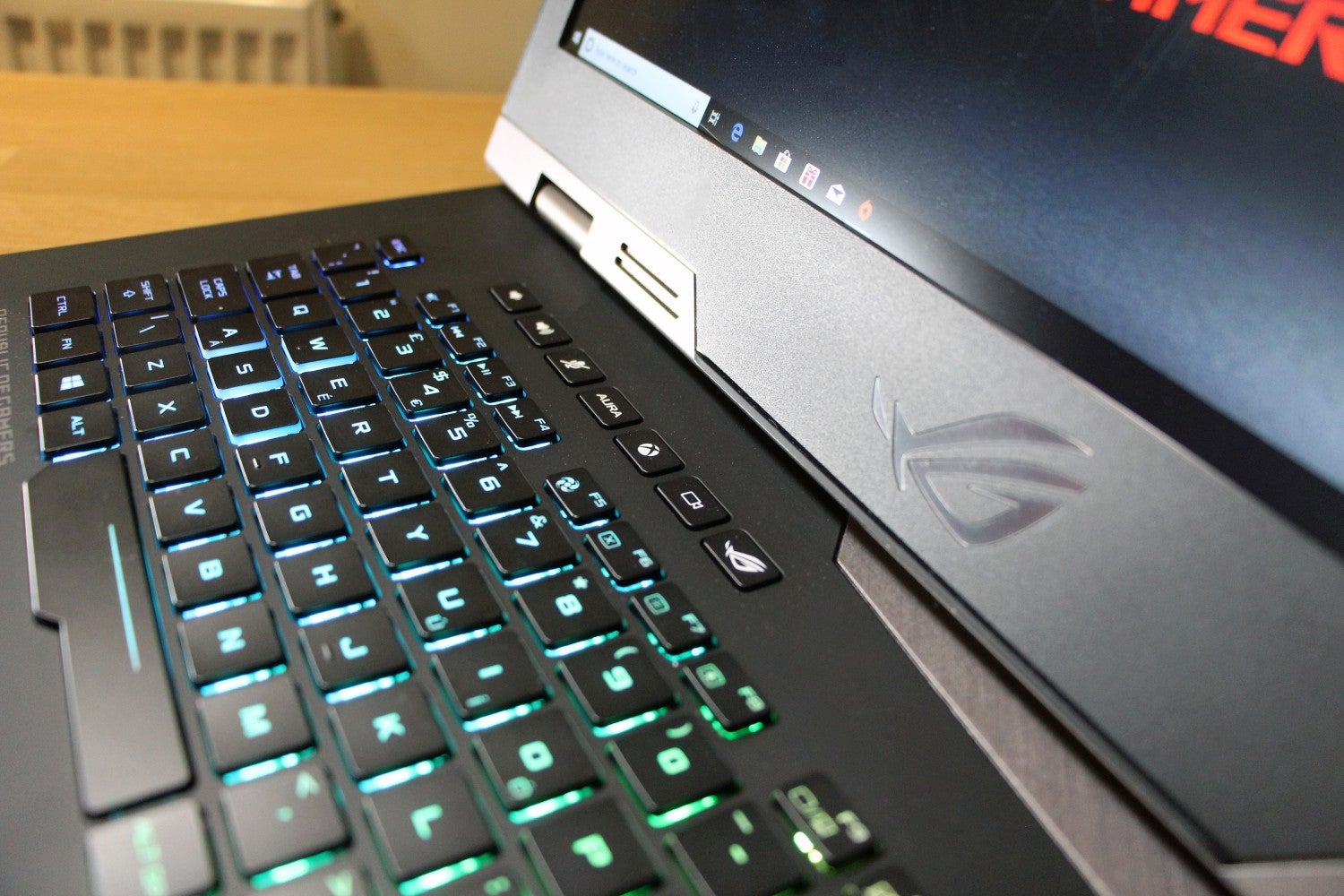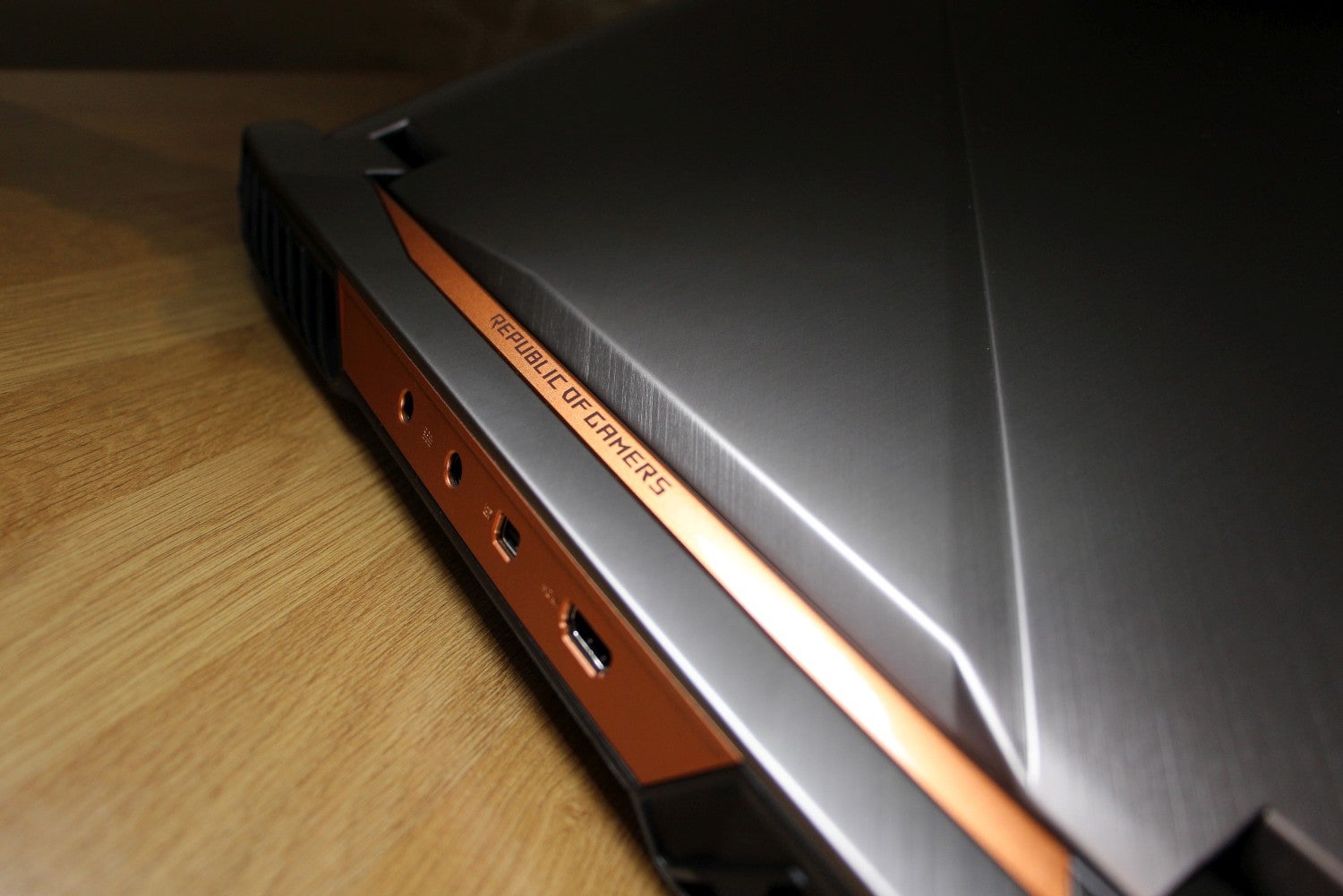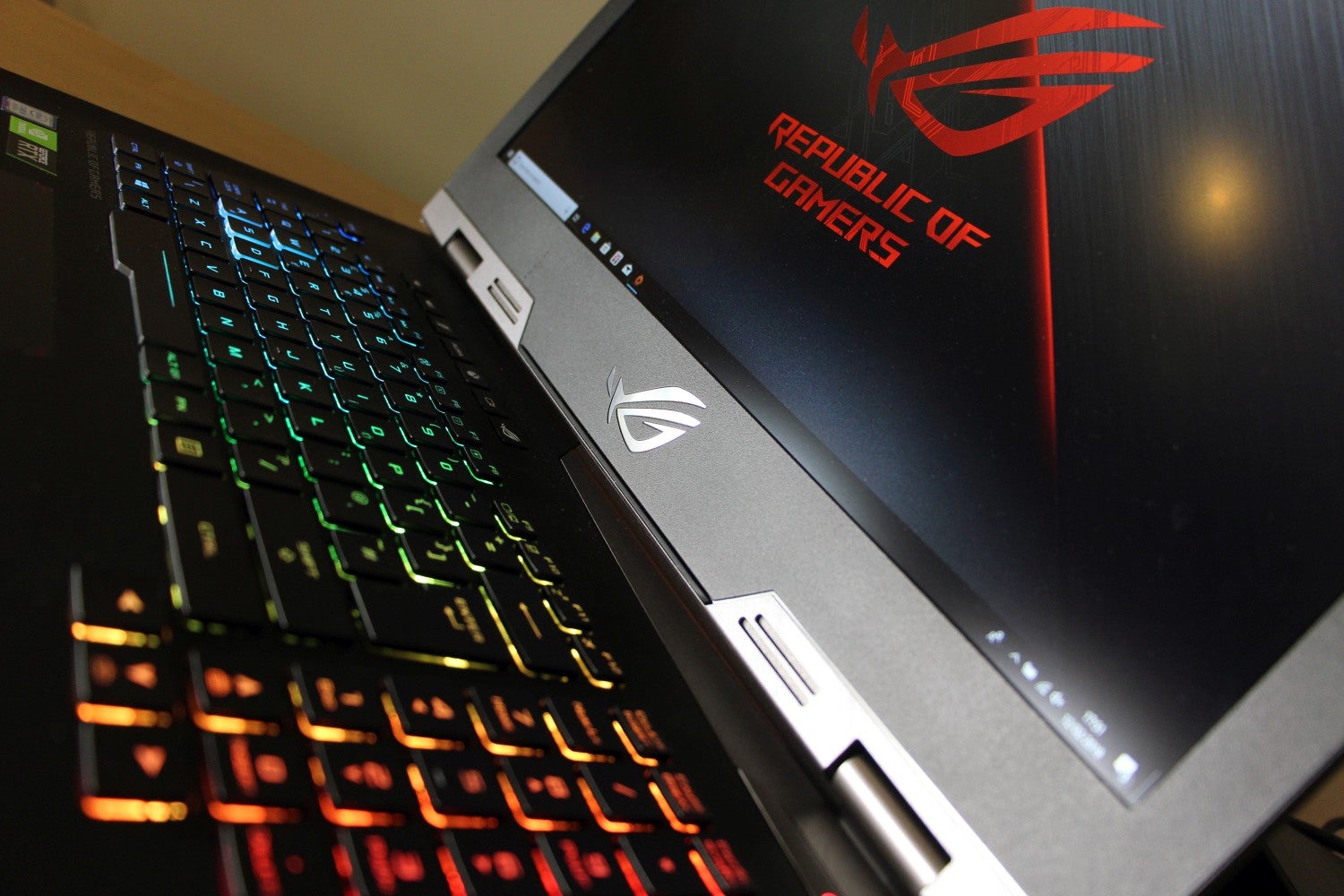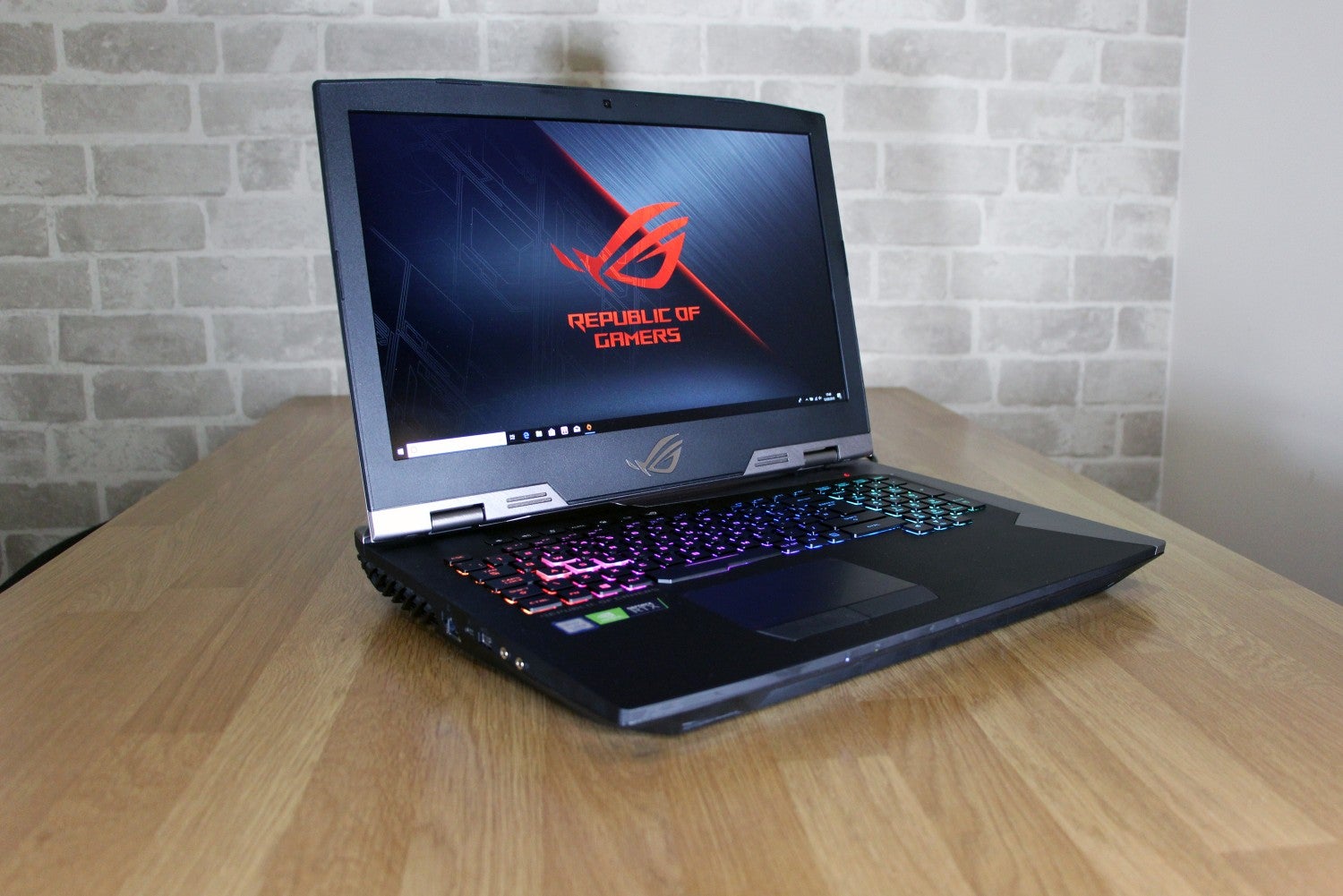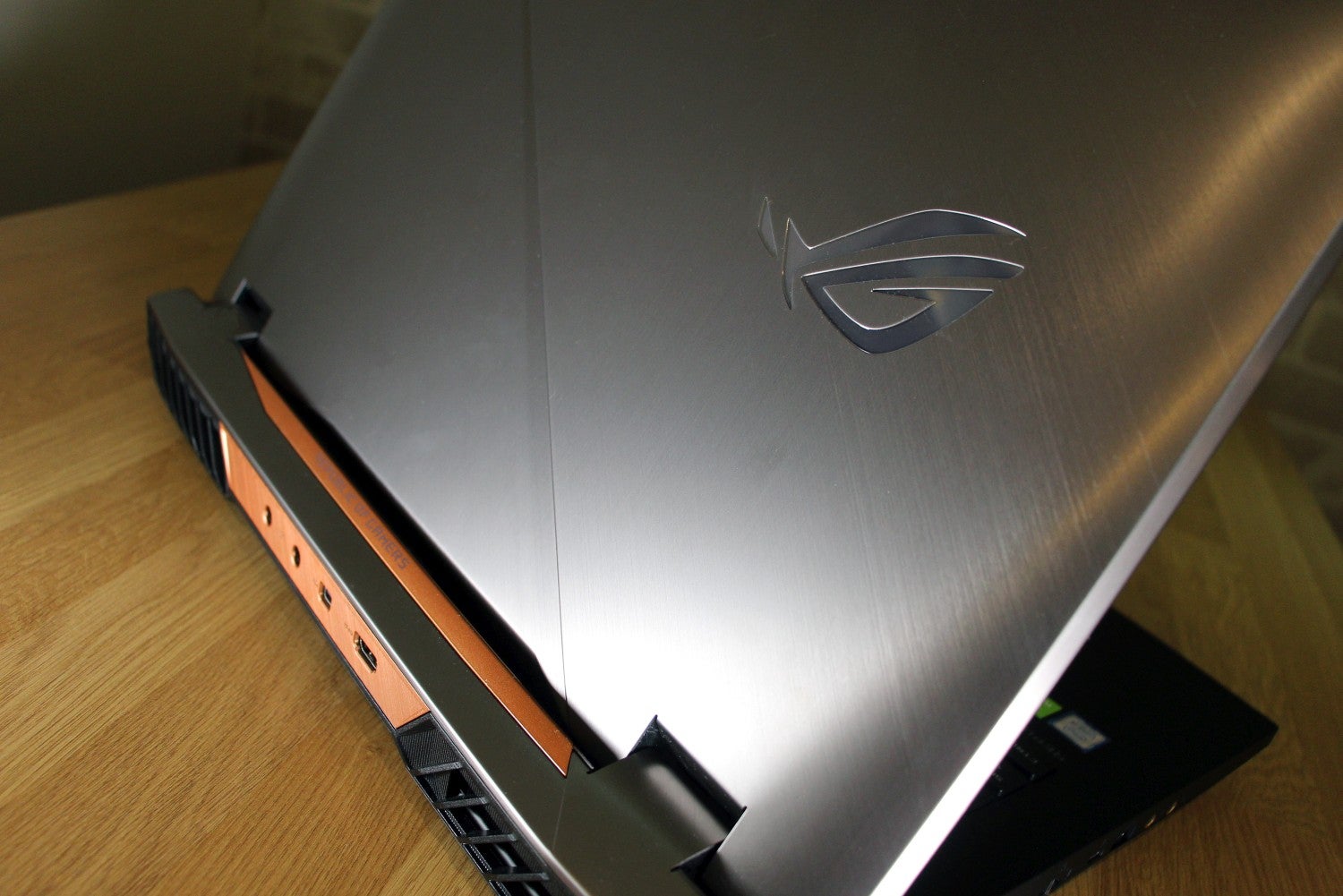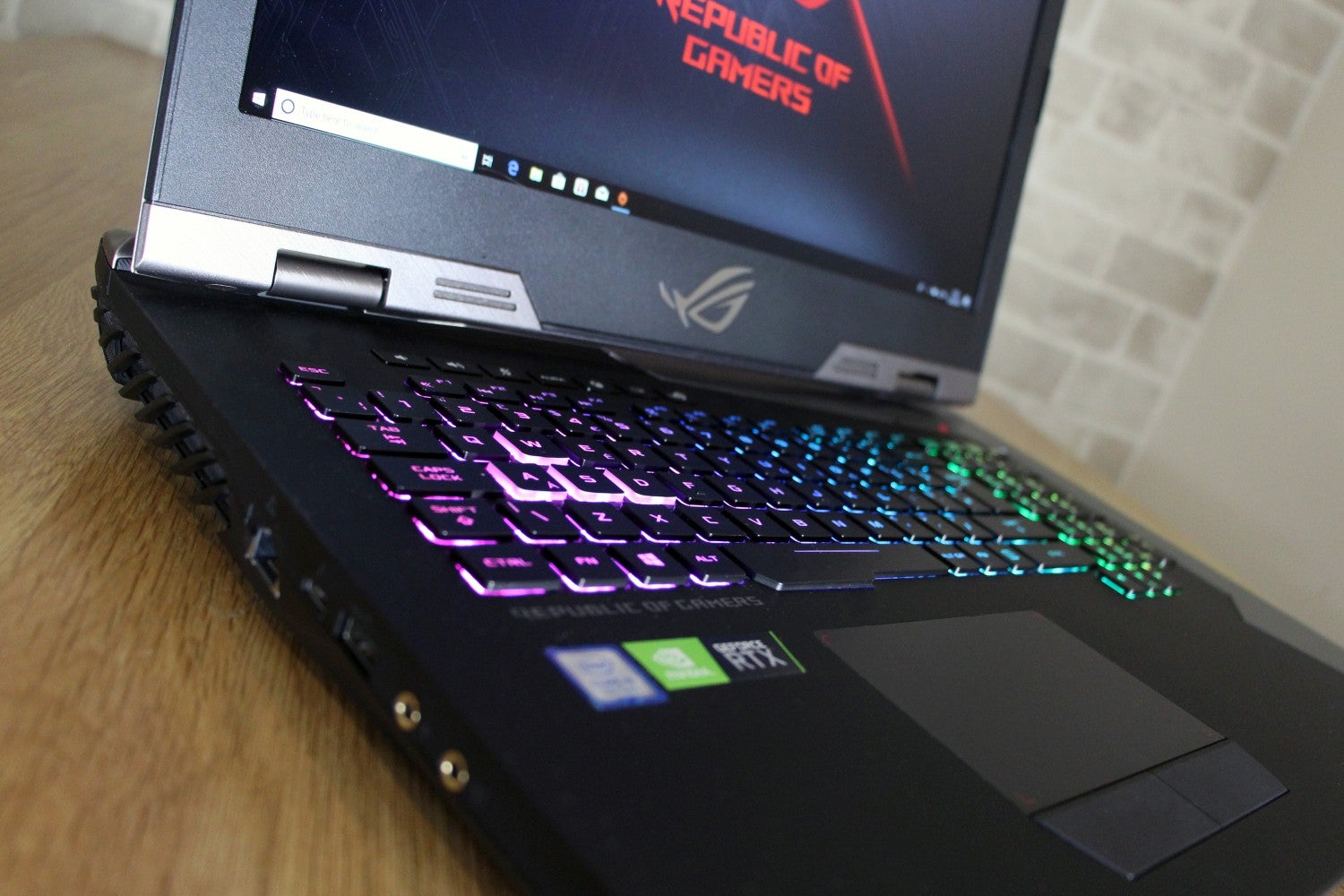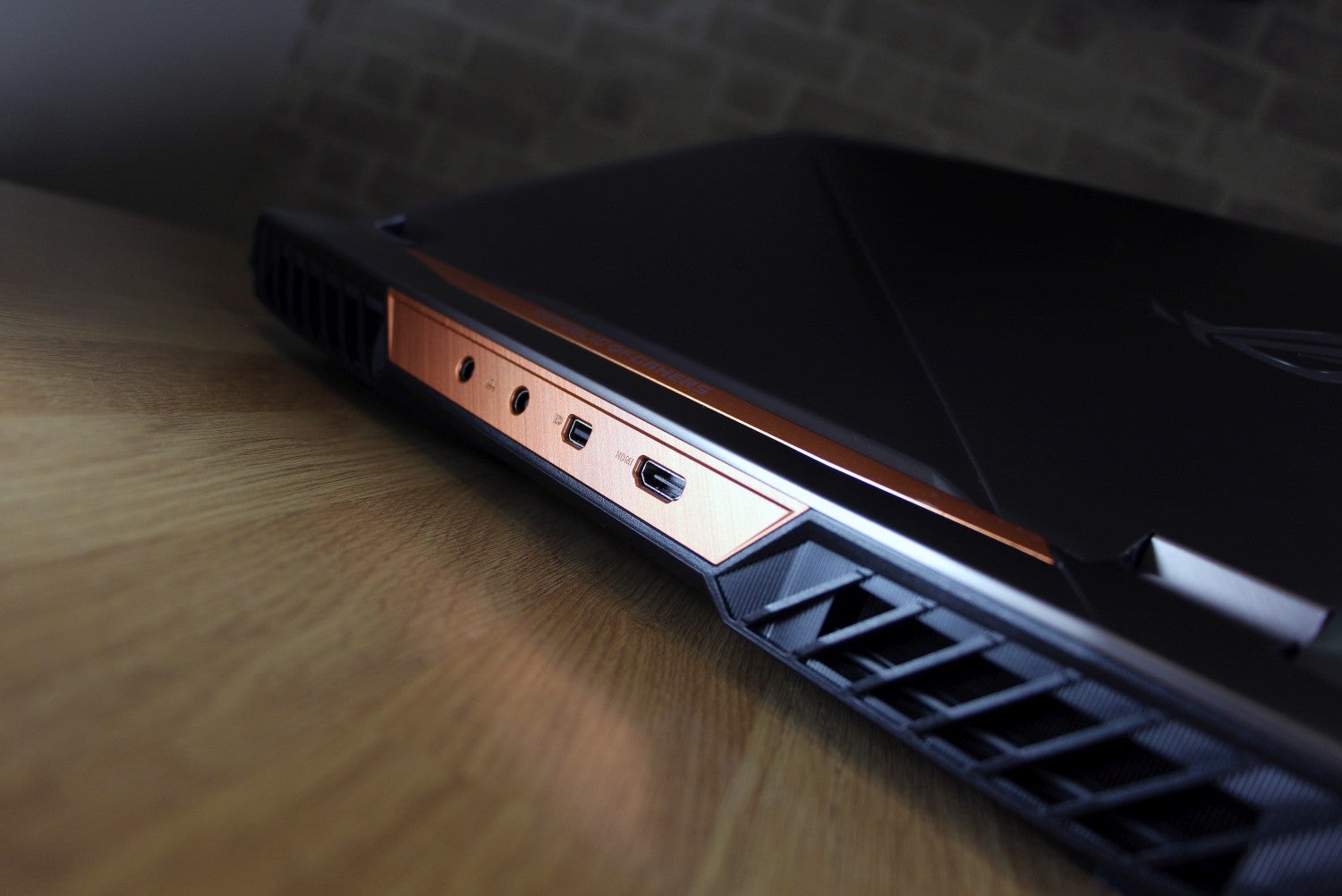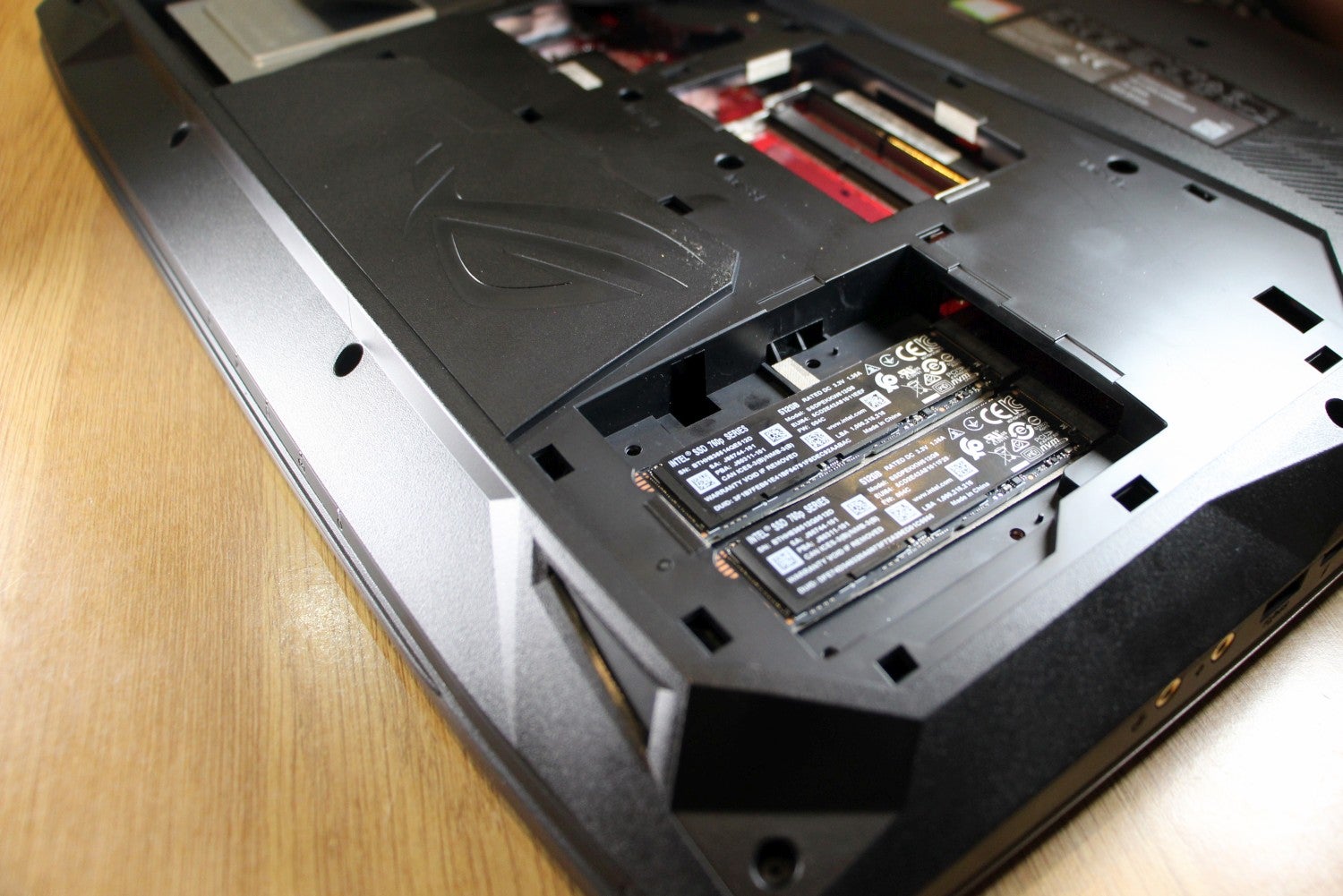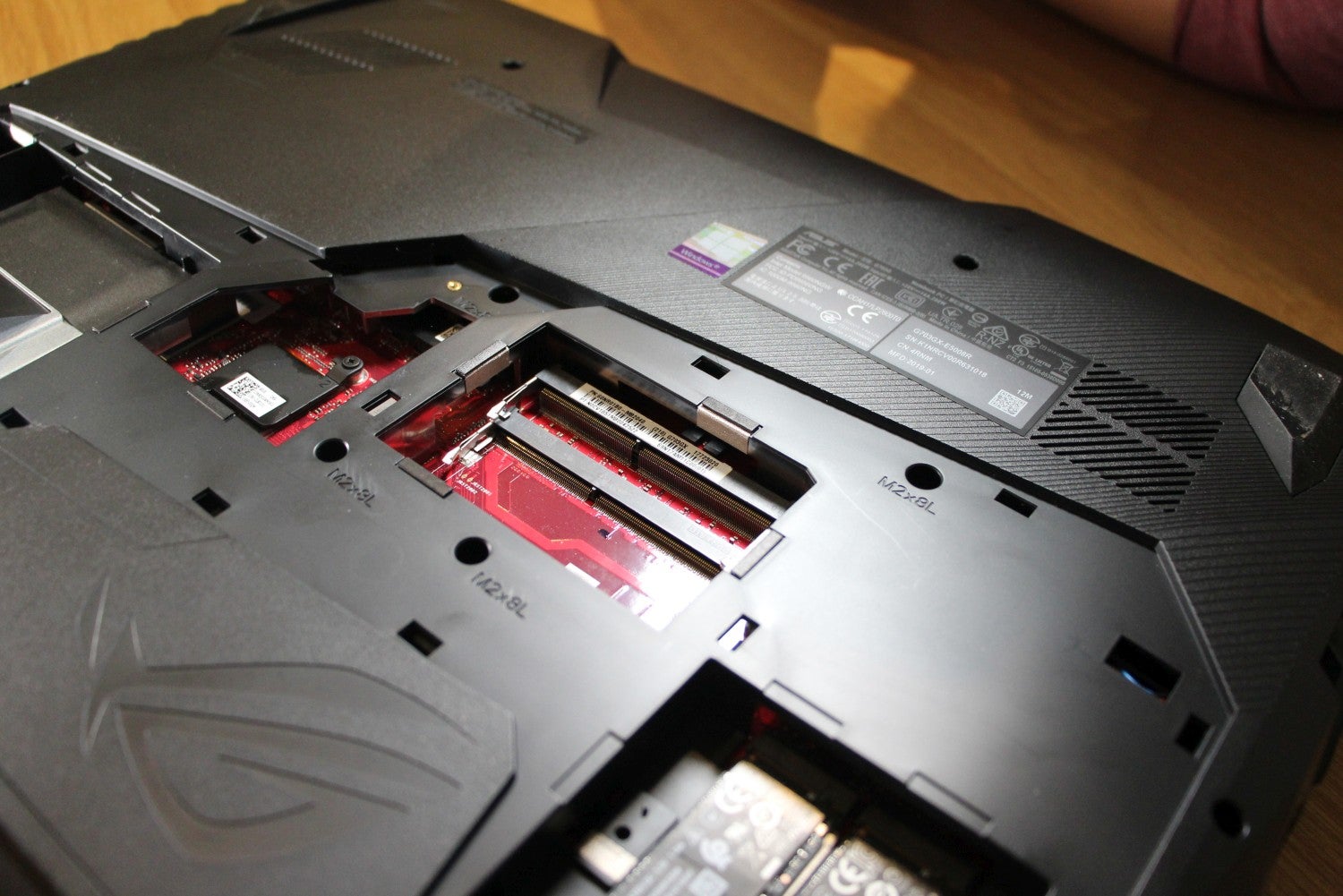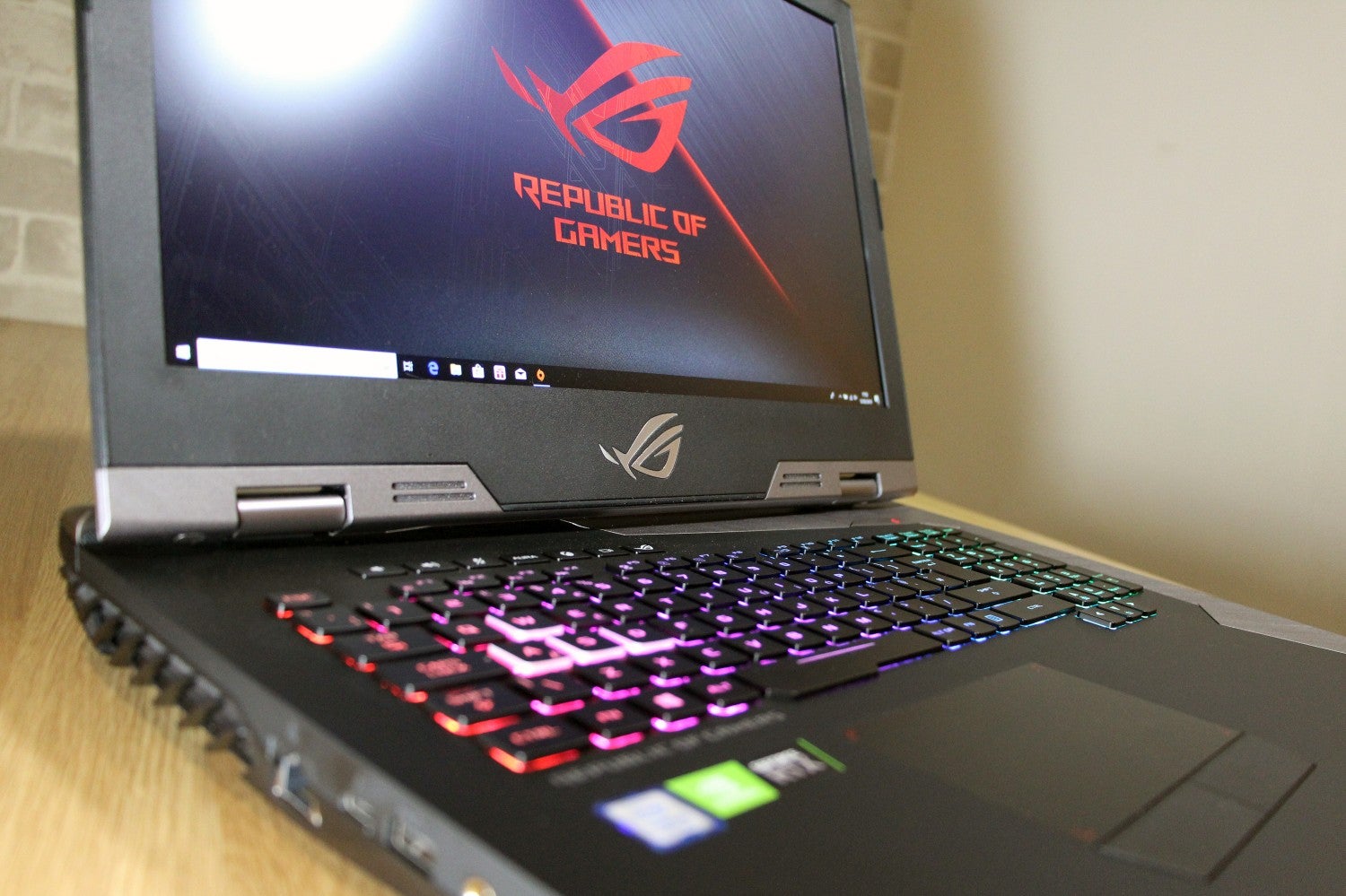Asus ROG G703GX Review
Asus ROG G703GX Review
The Asus ROG G703GX costs £4,500 and has an RTX 2080 - but is it worth it?
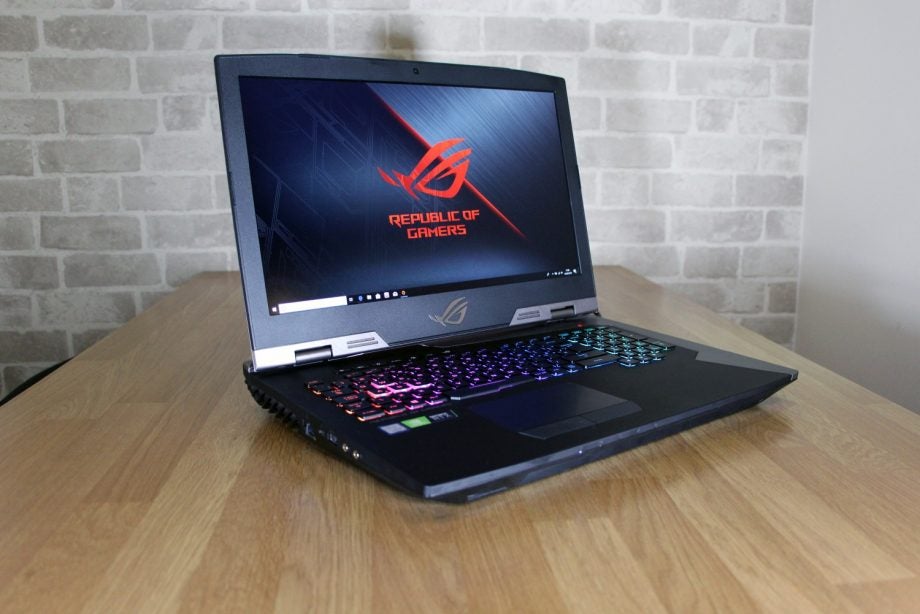
Verdict
A powerful desktop replacement, but ageing design and a huge price hamper its chances
Pros
- Incredible gaming performance
- Fantastic overclocked processor
- Rock-solid exterior
- Solid screen quality
Cons
- Vastly expensive
- Huge, heavy design
- Diminishing returns from some components
- Unsurprisingly poor battery life
Key Specifications
- Review Price: £4500
- 2.9GHz Intel Core i9-8950HK processor
- Nvidia GeForce RTX 2080 8GB graphics
- 17.3in 1,920 x 1,080 144Hz Nvidia G-Sync screen
- 32GB DDR4 memory
- 1.39TB Intel 7660p RAID 0 NVMe SSDs
- Windows 10 64-bit
- 2yr RTB warranty
What is the Asus ROG G703GX?
The Asus ROG G703GX is one of the beefiest and most powerful gaming laptops that we’ve ever reviewed – but it’s one of the most expensive, too, at £4,500.
That monster price does, at least, net you loads of high-end hardware. This laptop is the first we’ve seen with a new Nvidia GeForce RTX 2080, and it has a six-core Intel CPU, three SSDs and a 144Hz screen.
Asus ROG G703GX – Design and Build
A huge chassis is required to keep all of that hardware in check – and so, suitably enough, the Asus ROG G703GX is an absolute tank.
It’s 51mm thick at its chunkiest point and, at 4.7kg, you’re going to need a strong backpack and significant shoulders to lug this laptop to LAN parties or around the house.
The area around the keyboard is made from matte black aluminium, while the power button and hinges are highlighted with bolder metal.
At the rear you get the same visual touches that were introduced with the first G703 in early 2018 – including a huge ROG logo, and burnt orange accents between two huge air vents.
The lid’s ROG logo and the keyboard show off RGB LEDs. Above the keyboard there’s a row of buttons to control audio, handle streaming, and to open Asus’s software.
The G703GX makes a huge impression, and its strong aesthetic is paired with fantastic build quality. There’s no give in any surface – and we’d expect nothing less.
However, the lack of visual changes from last year does leave the G703GX looking a little dated: forthcoming rivals like the Acer Predator Triton 900 don’t add loads of eye-catching brushed metal to their dark designs – and Razer’s slate of existing machines are far subtler. Even the Aorus X9 is a little more modest.
The size, too, may make some gamers balk. The Aorus is older, but it still featured two Nvidia GPUs while being 30mm thick and weighing 3.6kg. Razer’s top notebooks are twice as slim and more than a kilo lighter than the G703GX.
Newer laptops will continue to make the G703GX look bulky. The Acer Predator is slimmer, and the Alienware m17 will feature RTX graphics inside a 23mm, 2.6kg chassis.
The G703GX does, at least, have good connectivity. On the sides you get three USB 3.1 connectors and a Type-C port alongside an SD card slot, Gigabit Ethernet and two audio jacks. At the rear you get HDMI 2.0 and mini-DisplayPort 1.4 outputs, both of which support 4K at 60Hz.
A significant portion of the base can be removed, too, which grants access to two free memory slots, the 2.5in hard disk bay and the NVMe SSDs.
Related: Best Games 2019
Asus ROG G703GX – Keyboard & Trackpad
The G703GX’s size ensures that the keyboard has a rock-solid base. That bodes well for hammering through long, frantic gaming sessions.
The keys have 2.5mm of travel, which is more than most gaming laptops. The layout is fine, too: the numberpad and cursor keys are set apart from the rest of the cluster, and the WASD buttons are highlighted. The buttons above the keyboard are shallow enough to avoid confusion, and the Function row has media options and fan controls.
The robust base and 2.5mm travel bode well, but hands-on time reveals minor issues. The buttons are fast, consistent and quiet, and good enough for esports, casual gaming and typing. However, the buttons are too soft – it feels like they hit a crash-mat when they bottom out.
That’s a problem when more laptops are deploying mechanical hardware. Some Aorus laptops already have mechanical keyboards, and the Acer Predator will include one. Those units are faster, crispier and snappier. If you take your games seriously, that matters.
The trackpad suffers similarly. The pad is fine, but the buttons push down too far and their clicking action isn’t snappy enough. Even an affordable USB mouse will have more speed and a shallower, crisper clicking action.
The keyboard has full RGB backlighting controlled from the Asus Aura app – a utility opened with a button above the keyboard or from within the Asus Armoury Crate tool that manages the G703GX’s software.
The Aura utility includes the usual RGB features: you can use various eye-catching effects to alter the lights, sync your keyboard’s lighting to other Asus hardware, opt for static lighting or customise each key individually. It’s a versatile set of lighting options, even if it doesn’t offer anything new.
Related: Best Lego Sets 2019
Asus ROG G703GX – Screen & Sound Quality
The G703GX comes with a 1080p Full HD screen. That sounds low when the ROG’s 17.3-inch diagonal and RTX 2080 graphics are considered, and its density level of 127ppi is unremarkable – fine for gaming and for general-purpose use, but not the highest I’ve seen.
The Asus ROG G703GX isn’t designed to deliver a high resolution, though. Instead, this screen concentrates on Nvidia G-Sync with a peak refresh rate of 144Hz.
Suddenly the 1080p resolution makes sense. To get the most out of G-Sync, games need to run at more than 100fps – and ideally as close to 144fps as possible. An RTX 2080 will run today’s top games and esports titles at those framerates at 1080p – but it won’t always manage it at a higher resolution.
We also like the G703GX’s 3ms response time. That’s the figure you’ll find on plenty of desktop monitors, and it’s good enough for every kind of game except the most demanding esports titles.
It’s a great bill of health for G-Sync and response times, and the G703GX has decent benchmark performance too.
The G703GX’s screen has a brightness level of 312 nits, which is high enough to handle any gaming scenario. The black measurement of 0.25 nits is fine – deep enough to make any dark area look absorbing. Those two figures combine for a contrast ratio of 1,248:1. That’s a good result that delivers punchy, vivid visuals.
Colour accuracy is reasonable. The G703GX’s Delta E of 2.7 is solid, but the colour temperature of 7,745K is chilly. That’s not going to ruin any gameplay, but it means the panel lacks a bit of warmth.
Similarly, the screen rendered 84.9% of the sRGB colour gamut. That’s fine – not enough to cause disruption in games – but it’s lower than the older G703, and only an average result when the wider market is considered. Uniformity is fine, at least, so visuals won’t be disrupted by an inconsistent backlight.
There are modes for various genres of game, but none are worth using. The racing mode ramps up the black point, which ruins the contrast and makes the screen look washed-out. The RPG mode makes the colour temperature too high, which leaves the screen with a blue pall. And the FPS option is too cool and with more colour disruption.
It’s easy enough to avoid those modes, though, and none of the G703GX’s benchmark issues are particularly troubling. The colours could be a little more accurate, of course, and the contrast could be a tad better.
When it comes to quality, you won’t find anything better on any other large gaming laptops, and games will look punchy and vibrant on the G703GX’s screen. The 144Hz G-Sync, 3ms response time and reasonably sharp density level all help.
The speakers are passable. They’re loud enough to fill a room, and there’s plenty of bass – but that bass does overwhelm the rest of the range, which means you may miss crucial high-pitched noises during games. If you’re serious, use a headset.
Related: Best Gaming Headset
Asus ROG G703GX – Performance
The RTX 2080 is one of Nvidia’s flagship cards, and the chip inside the G703GX is the same as desktop cards – so it’s got a formidable specification.
RTX 2080 has 2944 Turing cores and 8GB of GDDR6 memory. It’s got the various benefits of the Turing architecture, and it also has ray tracing – although that feature is currently only supported by Battlefield 5 and Metro Exodus.
By default, the G703GX runs in Asus’s own Turbo mode. This mode runs the RTX 2080 at a base speed of 1700MHz with a Boost pace of 1880MHz. The memory runs at 14,400MHz with Turbo mode chosen.
Different performance modes can be chosen in the Asus Armoury Crate utility. The Balanced mode runs the GPU at more reasonable core and memory clocks of 1575MHz and 14,000MHz – although the former is still a little higher than the RTX 2080’s reference clock.
There are also Silent and Windows modes, which drop the GPU speeds a little further.
In Turbo mode the RTX 2080 proved impressive. It zipped through Middle Earth: Shadow of Mordor at 201fps, which was almost 40fps better than the GTX 1080 inside last year’s G703. In Shadow of the Tomb Raider it averaged 133fps – 36fps better than the GTX 1080.
In a trickier game, Deus Ex: Mankind Divided, the RTX 2080 averaged 87fps at Ultra settings. That’s thirteen frames better than the older GPU.
The RTX 2080 easily beats the GTX 1080. And, pleasingly, its triple-figure scores mean that the G703GX will handle most of today’s top games and every esports title at a pace where Nvidia G-Sync will work smoothly. It’ll also run VR headsets and external screens with no issues.
However, the RTX 2080’s Deus Ex score indicates that the most intensive single-player games won’t gain as much from G-Sync unless graphics quality is reduced.
There’s also the G703GX’s alternative performance modes to consider. Dropping down to Balanced mode – with the GPU at its normal speed – didn’t cause a huge performance drop. In Deus Ex, the G703GX was eight frames slower in Balanced mode.
However, using Windows or Silent options saw a bigger impact on speeds. In Windows mode, the ROG’s Deus Ex scored dropped to 51fps, and it hit 66fps in Silent mode.
They’re not vast drops, though, and the game was still playable in all of these modes as long as you’re not fussed about G-Sync.
Theoretical tests show the relatively light touch that Asus’ speed modes have on gaming. In 3D Mark Fire Strike Ultra and in Turbo mode the G703GX scored 6,588 points – and every other performance mode returned a result that was within 700 points.
These scores are better than the GTX 1080, too. Last year’s G703 scored 5,349 points in the same test.
Activating ray tracing saw a similar pattern emerge: in Battlefield 5 without Nvidia’s new feature the game averaged 103fps, but turning ray tracing on saw that result drop to 75fps.
Your mileage will vary with these modes, and with ray tracing, it all depends on what games you’re playing and what framerates you want to achieve. What’s clear, though, is that the RTX 2080 is very fast, and far quicker and more versatile than the hardware it’s replacing.
The GPU is paired with an Intel Core i9-8950HK. It’s one of Intel’s most powerful mobile chips, as seen in gaming laptops like the Acer Predator Helios 500.
The i9-8950HK has six cores that can address twelve threads, and it has a solid 2.9GHz speed. It can reach a huge Turbo peak of 4.8GHz, and its HK suffix means it can be overclocked.
Forthcoming Alienware 17 machines will have similar Core i9 processors, while the Acer Predator will have a Coffee Lake-based Core i7 CPU. The G703GX’s Core i9 silicon is an upgrade over the i7-7820HK in the older G703. That chip was unlocked, but it only had four cores and a Turbo peak of 3.9GHz.
By default, in Turbo mode, the Core i9-8950HK is overclocked to 4.8GHz. In Balanced mode the CPU runs at 4.4GHz. In Windows mode it’s around 50MHz slower, and in Silent mode the CPU drops to 2GHz. Users also have the option to overclock the six cores to 5GHz manually.
The six-core processor is formidable. In Turbo mode and in Geekbench the CPU returned single- and multi-core scores of 5,736 and 25,789 points – scores that aren’t distinguishable from top-tier desktop CPUs.
That former result is around 500 points better than the older Core i7 CPU included with last year’s ROG G703, while the latter is a mighty 8,000 points ahead.
Switching to different operational modes had a significant impact on performance. Using Balanced mode dropped the single- and multi-core results to 4,035 and 15,876 points. Windows mode offered similar scored, while the Silent option virtually halved the CPU’s scores in Turbo mode.
Those scores mean that no game will be bottlenecked, and that day-to-day computing will run without any delay – at least in most of the machine’s modes of operation. The Asus will also handle content creation, from photo and video editing to streaming. Browsers with dozens of tabs won’t phase this machine, and it’ll run hard-noise productivity tools.
The only thing you won’t be able to do is handle intense workstation-level tools, but no-one’s buying the G703GX for that anyway.
The lightning-fast CPU is joined by formidable storage. Three Intel 760p SSDs in RAID 0 provide a 1.39TB boot drive that delivers sensational sequential speeds. In our tests it returned read and write speeds of 6832MB/sec and 4484MB/sec. Both scores are several times faster than any single NVMe drive, and that pace is manifested by incredibly quick boot and loading times.
Elsewhere, the Asus has 32GB of 2666MHz DDR4 memory. Connectivity extends to dual-band 802.11ac wireless, Gigabit Ethernet and Bluetooth 5.0.
They’re tempting, powerful components, but the G703GX’s high-end specification has its disadvantages.
Take the CPU, memory and storage – none of which are strictly necessary. No games need a six-core CPU like this, and few titles use 32GB of memory. Loading times will be good with the triple-SSD RAID array, of course, but having a single SSD won’t cause big delays.
It’s possible to get an RTX 2080 laptop for less if you’re willing to abandon those luxuries. Machines are available now for around £2,499, and you’ll still get 16GB of memory, Core i7 processors and a fast SSD. Some still have 144Hz G-Sync displays.
The huge power inside the G703GX also hits battery life. It managed a reasonable four hours in Powermark, but barely more than an hour in a gaming benchmark. This is not a system designed to be away from the mains – and you don’t get as much grunt without the two power packs attached, either, because using the battery disables Turbo mode.
And then, finally, there’s the area where the G703GX’s high-end components have the biggest impact: thermal performance.
When using Turbo mode, the G703GX is one of the loudest laptops I’ve ever tested. When playing demanding games or pushing the CPU the laptop produced a huge noise that modulated between several ear-shattering tones.
You simply can’t play top games or properly push the components without making a huge amount of noise. Speakers or a headset will help, but you’ll still hear the fans – and your neighbours at LAN parties won’t thank you either.
Using Balanced mode cuts down the noise a little, but it’s still there – and it’s still there in Windows mode, too, with a low fan rumble that’s still noticeable. The Silent mode is truly quiet in low-end tasks, at least, but performance levels are drastically reduced here.
It’s certainly possible to make this machine quieter, then, but you’ll have to be running less taxing games and operating at lesser performance modes – and that’s not what this machine is for.
Related: Best VR Games 2019
Should I Buy the Asus ROG G703GX?
The Asus ROG G703GX is a powerful machine that’s looking a little too long in the tooth.
It’s certainly got its good points. The RTX 2080 is fast, and the six-core CPU, triple-SSD RAID array and 32GB of memory ensure lighting speed in any application. The screen is good, build quality is rock-solid, and the keyboard isn’t bad.
This is an older chassis with newer components, though, and it shows. The G703GX is heavier and thicker than every rival, and its keyboard pales alongside mechanical hardware. The cooling gear can’t cope with the components, which means it’s hugely loud.
It’s expensive, too. Its £4,500 price is reduced to £4,000 on some websites, but that’s still loads more than many other laptops that have RTX 2080 GPUs without the ROG’s bells and whistles. It’s loads more than equivalent desktops, too: a full-size ATX tower or a smaller micro-ATX PC with a comparable specification will cost around £2,500 – or maybe a little less.
The Asus ROG G703GX offers tremendous power in a bomb-proof package – but rivals offer similar performance in slimmer, more affordable designs. This laptop is showing its age, so I’d only recommend if it you particularly desire the overpowered specification and the hefty, imposing build.
Verdict
The Asus ROG G703GX delivers impressive performance, and it has rock-solid build quality alongside a good screen. It’s bulkier than rivals, though, and some components offer minimal performance gains. Battery life is poor, thermal performance is disappointing, and it’s hugely expensive. It’s tricky to recommend – unless you do need all of its showstopping components inside a single laptop.
How we test laptops
Unlike other sites, we test every laptop we review thoroughly over an extended period of time. We use industry standard tests to compare features properly. We’ll always tell you what we find. We never, ever, accept money to review a product.


